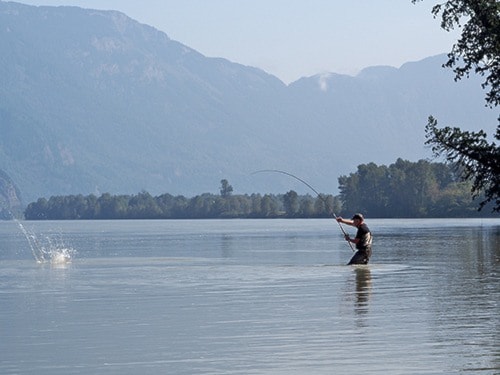We will have to wait and see how the final numbers come in — but this year’s sockeye run is so far living up to the high expectations. Fishers are packing the river bars from Deroche to Hope from dawn till dusk, trying to land their daily limit of two sockeyes and one spring (chinook) salmon.
Sockeyes mature on a four-year cycle, so this year’s returning fish were spawned from the remarkable 2010 run, which saw approximately 28.3 million adult sockeye… after the disastrous 2009 run of only 1.6 million, according to Department of Fisheries and Oceans (DFO) records.
Local restaurants and motels are getting a boost out of the bonanza but the most pressing need for fisherfolk is a place to get a licence and stock up on gear. When Cheyenne Sports closed in the fall of 2011, Hope was left with nowhere to go for fishing supplies.
Lily Liu, owner of the new Trends on End sports shop on Wallace Street, had a smaller shop on Commission Street last year but she wasn’t stocked up for fishing.
“I started carrying fishing gear when I moved here in February,” said Liu on Monday, while juggling requests from a line of customers. “We’ve sold hundreds of licences so far. I haven’t counted them all yet.”
Some parts of the river — especially when fished by inexperienced fishers — are highly prone to snagging the weights and hooks. This brings the customers back to town, to replace their lost gear… so Liu has to stay on top of her orders.
She said that Bouncing Betties in the two to three ounce size are the most popular weight — and people who want to hold onto their gear for more casts favour “leader savers,” hand-made in Chilliwack.
“All of the stores are having trouble keeping them in stock,” said Liu. “It’s crazy this year! One day, there were 20 people in the store and five of them wanted licences. I was typing so fast.
“We’re open seven days a week, 7 a.m. to 6 p.m.,” said Liu. “People say, ‘We have to get our stuff earlier.’
“We’ll be back to the normal 9 a.m. to 6 p.m. when the season is over. The closing date is unknown — but it will be longer than normal because of the number of fish,” figured Liu.
Terry Gyorfi (pronounced “Jer-fee”) of Chilliwack is a regular at the Exit 153 bar, just downstream of Jones Creek, where’s there’s plenty of parking and the walk to the river is relatively short and easy.
It’s a tough place to fish, though, as the river-bottom rocks are bigger and the snags, plentiful. Gyorfi estimated that he lost $20 to $30 worth of weights and hooks to get his two sockeyes on Monday. He’s usually been getting his two per day and the odd spring — but Monday was especially tough on his gear, despite his attempts to avoid the snags.
Where most of the 30 to 40 fishers were casting from the shore, or were wading to their bare knees, Gyorfi went upstream and was up to his elbows in the water, in his chest waders. The plan was to get out past the worst of the tangled lines left by earlier fishers. That was the plan, anyway.
Gyorfi figured the tangled lines are mostly caused by people with spin-cast reels, which don’t allow you to control the slack, like you can on a level-wind reel. The other killer is the afternoon wind that puts a curve in your cast, he said. This gives you a slack line for the first part of your bottom-bounce — prime conditions for getting snagged.
That Gyorfi can even get himself to the riverbank is a miracle, as he was badly injured in a construction accident in 1993, falling three storeys and permanently losing the use of his left ear — and the balance correction that went with it. He’s now on a disability pension.
Over the years, he said, he has gradually worked up his strength and balance to the point where he can safely get out in the deeper water.
“For me, I don’t call it fishing,” said Gyorfi. “I call it physiotherapy.”
